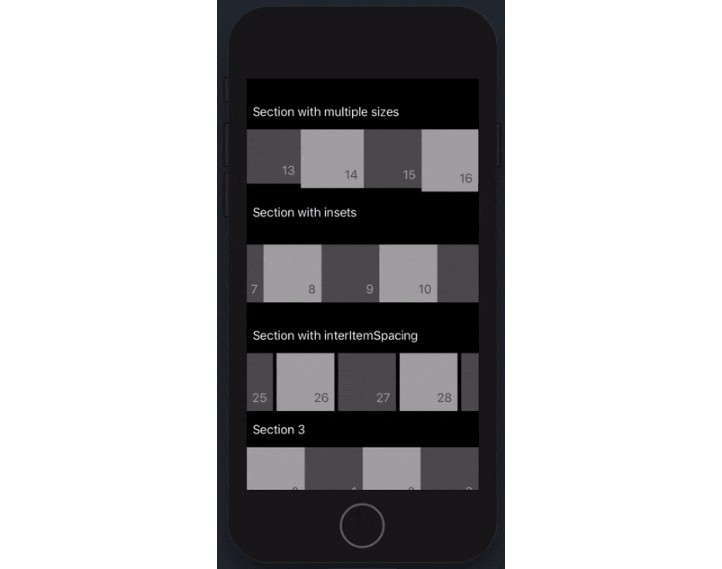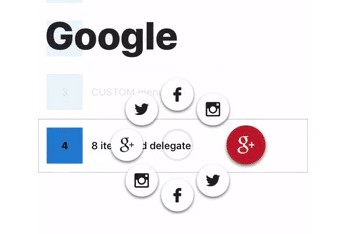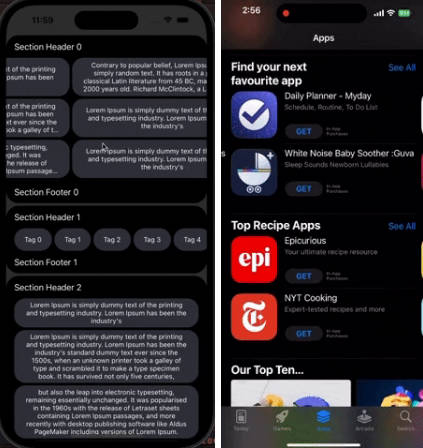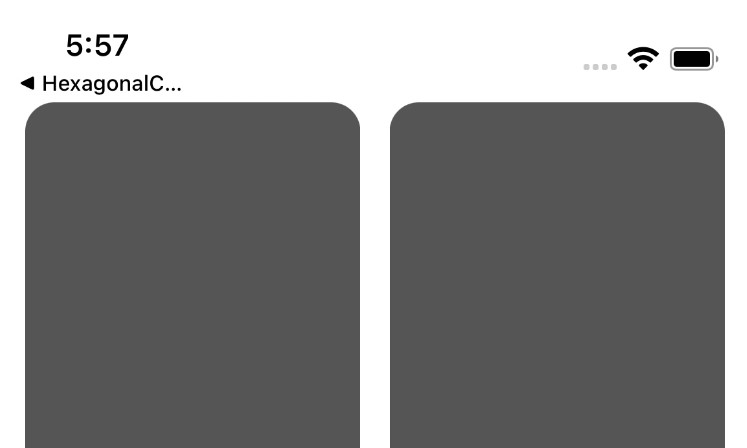JEKScrollableSectionCollectionViewLayout
A drop-in replacement of UICollectionViewFlowLayout which allows horizontally scrolling sections. Uses UICollectionViewDelegateFlowLayout to query layout information, so usually no code changes are needed to replace your current flow layout with this one.
Note however that this is not a subclass of UICollectionViewFlowLayout, so it might not respond to certain messages, for example estimatedItemSize which is not implemented (yet). This also means that it will not read measurements set in interface builder on a UICollectionViewFlowLayout, and you have to set the measurements in code. Check the example project for a full setup.
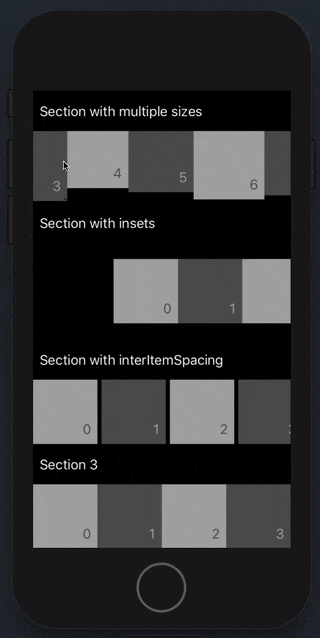
Features
- Properly supports inserts/deletes/moves (even between different sections)
- ... since it does not create multiple
UICollectionViews like this problem is normally solved
- ... since it does not create multiple
- (almost) drop in replacement for
UICollectionViewFlowLayout - A simple layout object - doesn't need to subclass or modify
UICollectionViewin any way- ... leading to efficient reuse of cells and support for prefetching
- Section background views (as optional supplementary views)
Installation
- CocoaPods:
pod 'JEKScrollableSectionCollectionViewLayout' - Simply copy
JEKScrollableSectionCollectionViewLayout.h/.minto your project
Planned features
- Support for
sectionHeadersPinToVisibleBounds - Support for multiple rows in single section
Section backgrounds
The layout has support for showing background views behind each seaction.
To enable it, you have to set layout.showsSectionBackgrounds = YES when setting
up your layout object.
Then, collectionView:viewForSupplementaryElementOfKind:atIndexPath: will be called
in your data source with the JEKCollectionElementKindSectionBackground kind. Dequeue
and return a view like you would normally with section headers and footers.
Observing section scrolling
The JEKCollectionViewDelegateScrollableSectionLayout-protocol allows you to observe
and manipulate scrolling per horizontal section. To use it, simply conform to this protocol
instead of UICollectionViewDelegateFlowLayout (which is then implicitly conformed).
The protocol closely resembles UIScrollViewDelegate and exposes the following optional methods:
- (void)collectionView:(UICollectionView *)collectionView layout:(JEKScrollableSectionCollectionViewLayout *)layout section:(NSUInteger)section didScrollToOffset:(CGFloat)horizontalOffset;
- (void)collectionView:(UICollectionView *)collectionView layout:(JEKScrollableSectionCollectionViewLayout *)layout sectionWillBeginDragging:(NSUInteger)section;
- (void)collectionView:(UICollectionView *)collectionView layout:(JEKScrollableSectionCollectionViewLayout *)layout sectionWillEndDragging:(NSUInteger)section withVelocity:(CGFloat)velocity targetOffset:(inout CGFloat *)targetHorizontalOffset;
- (void)collectionView:(UICollectionView *)collectionView layout:(JEKScrollableSectionCollectionViewLayout *)layout sectionDidEndDragging:(NSUInteger)section willDecelerate:(BOOL)decelerate;
- (void)collectionView:(UICollectionView *)collectionView layout:(JEKScrollableSectionCollectionViewLayout *)layout sectionWillBeginDecelerating:(NSUInteger)section;
- (void)collectionView:(UICollectionView *)collectionView layout:(JEKScrollableSectionCollectionViewLayout *)layout sectionDidEndDecelerating:(NSUInteger)section;
Usage example
Since this is a drop-in replacement for UICollectionViewFlowLayout, normally
you can just change the layout object in your current flow-layout based collection views.
Here's an example of a bare minimum UICollectionViewController with two horizontal sections.
class MyViewController: UICollectionViewController {
override func viewDidLoad() {
super.viewDidLoad()
let layout = JEKScrollableSectionCollectionViewLayout()
layout.itemSize = CGSize(width: 50, height: 50);
layout.headerReferenceSize = CGSize(width: 0, height: 22)
layout.minimumInteritemSpacing = 5
collectionView.collectionViewLayout = layout
collectionView.register(UICollectionViewCell.self, forCellWithReuseIdentifier: "cell")
collectionView.register(UICollectionReusableView.self, forSupplementaryViewOfKind: UICollectionView.elementKindSectionHeader, withReuseIdentifier: "header")
}
override func numberOfSections(in collectionView: UICollectionView) -> Int {
return 2
}
override func collectionView(_ collectionView: UICollectionView, numberOfItemsInSection section: Int) -> Int {
return 10
}
override func collectionView(_ collectionView: UICollectionView, cellForItemAt indexPath: IndexPath) -> UICollectionViewCell {
let cell = collectionView.dequeueReusableCell(withReuseIdentifier: "cell", for: indexPath)
cell.backgroundColor = UIColor.gray
return cell
}
override func collectionView(_ collectionView: UICollectionView, viewForSupplementaryElementOfKind kind: String, at indexPath: IndexPath) -> UICollectionReusableView {
let header = collectionView.dequeueReusableSupplementaryView(ofKind: kind, withReuseIdentifier: "header", for: indexPath)
header.backgroundColor = UIColor.blue
return header
}
}
